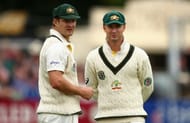
Wobble Wobble: James Anderson (L) of England celebrates the wicket of Shane Watson of Australia during day four of the 2nd Ashes Test at Lord’s Cricket Ground on July 21, 2013 in London, England. Watson has been dismissed LBW thrice in four innings. (Getty Images)
When this talented and much-hyped youngster debuted for his country, he was immediately put under a lot of pressure. People started touting him as the next big thing, but then BAM! The youngster got injured time and again, affecting his prospects of cementing his place in the side.
When he did manage to establish himself as one of the finest limited overs player of his time after returning to fitness, he failed in the Test arena (despite his obvious potential), avoided doing his “homework” and got into serious disputes with his captain. This not-so-young-anymore “youngster” happens to be the one and only Shane Robert Watson.
Australia have, for the most part, enjoyed a healthy and fierce rivalry with both England and South Africa. During the late 90s and early 2000s, both the Proteas and England had a budding all-rounder each. One is still active and a modern day great, while the other is retired but played a significant role in England’s twin Ashes triumphs in 2005 and 2009. The two gentlemen, Jacques Kallis and Andrew Flintoff, are quite easily two of the best all-rounders of the modern game.
It was during the early stages of their careers that the Australians started looking for a Kallis and Flintoff of their own, and their quest ended with a young Queensland bloke, who was representing Tasmania in domestic cricket.
Watson made his debut in and against South Africa in 2002, but as has been the case throughout his career, went down injured and did not play for a year. Unfortunately for ‘Watto’, the injury happened just ahead of the 2003 World Cup, which meant that he missed the marquee event. He was replaced by another Queenslander, Andrew Symonds, who performed impressively to cement his place in the one-day side.
Upon his return, Watson went on to establish himself in the one-day side but could not make a return to Tests, getting injured and losing his place to Symonds and Michael Clarke. Once Symonds saw his own career come to an end after a number of off-field controversies, it was Watson who replaced him in the Test side and batted at number six, but it was only during the 2009 Ashes that he was promoted to opening in Tests as well.
He then went on to establish himself as the world’s leading all-rounder for the next two years, but his from with the bat started to deteriorate once Ricky Ponting stood down as captain and Clarke took over.
There is no questioning Watson’s abilities as a player; he is a proven match-winner in ODIs as well as T20s. He was Shane Warne’s trump card during the inaugural IPL as the Rajasthan Royals surprised one and all by storming to the title and was rightly adjudged Man of the Tournament. He also played an integral role in Rajasthan making the playoffs during the sixth season, once again being adjudged the MVP.
And who can forget his breath taking 185* against Bangladesh in April 2011. He also single-handedly won the first match of the 2010-11 CB series against England with a sublime 161*. He even won the Man of the Tournament award at the 2012 ICC World T20. How can anyone even doubt this man’s unlimited potential?
However, these are the shorter formats’ performances we are talking about. His Test performances have not been quite up to the mark and Watson hasn’t managed to score a Test century in almost three years, having last got to three figures against India in October 2010.

Frosty relationship: Michael Clarke and Shane Watson of Australia look on during day two of the Tour Match vs. Worcestershire at New Road at New Road on July 3, 2013 in Worcester, England. (Getty Images)
Under Ponting, Watson played mostly as an opener, averaging 41.55 with two hundreds. However under Clarke, he has regularly shifted his positions as his average has fallen down to 26.46. His performances in the pre-Ashes trip to India were hardly worth remembering, as he finished the series with 99 runs in six innings at 16.50 without a single fifty.
The homework-gate scandal made matters worse for him as he considered quitting Test cricket altogether. His form hasn’t been good in the on-going Ashes either, where he has scored 109 runs at 27.50 (that the other Aussie batsmen are struggling as well is a different thing). As of this piece, he has been dropped from the tour game against Sussex to work on his technique that has seen him getting out leg before wicket thrice in four innings.
His “falling out” with Clarke led to Watto being called a “cancer” by his skipper, according to recently sacked coach Mickey Arthur. He will have to do something special to rescue his team’s faltering Ashes campaign and resurrect his own Test career. An average of 35 and 41 in Tests and ODIs respectively may bode well for any other all-rounder, but the fact that this all-rounder happens to be Watson is quite baffling.
At the end of his career, Watson may not go down as a flop, but as someone who could not deliver as per his potential. And for that to change, Watson the Test batsman will have to stand up.
The question is, will he?
Looking for fast live cricket scores? Download CricRocket and get fast score updates, top-notch commentary in-depth match stats & much more! 🚀☄️
